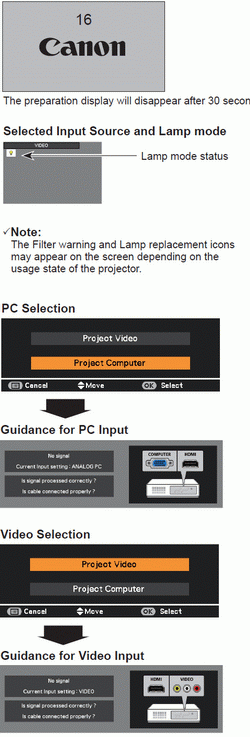|
|
Turning On and Off the Projector
| Article ID: ART137178 |
| |
Date published: 05/13/2015 |
| |
Date last updated: 09/01/2015 |
Description
Turning On and Off the Projector
Solution
Turning On the Projector

Complete peripheral connections (with a computer, VCR, etc.) before turning on the projector.
- Connect the projector’s AC power cord into an AC outlet. The POWER indicator lights red. Open the lens cap.
- Press the POWER button on the top control or on the remote control unit. The POWER indicator lights green and the cooling fans start to operate. The preparation display appears on the screen and the countdown starts.
- After the countdown, the input source that was selected the last time and the Lamp mode status icon appear on the screen for about 4 seconds.
- If there is no signal input when start on the projector, or the current signal is missed while operating the projector, the VIDEO/PC selection window will be displayed on the screen, please move the pointer to input source desired by pressing the Point
 buttons and press the OK button. And then follow the input signal guidance window to correct the signal and connection. buttons and press the OK button. And then follow the input signal guidance window to correct the signal and connection.
If the projector is locked with a PIN code, PIN code input dialog box will appear. Enter the PIN code as instructed on the next page.
Note:
-
When the Logo select function is set to Off, the logo will not be shown on the screen
-
When Countdown off or Off is selected in the Display function, the preparation display will not be shown on the screen
-
When the Auto input function is set to On 2, the input signal will be searched automatically
- When Off is selected in the Display function, the VIDEO/PC selection window and the input signal guidance window are not shown on the screen
|
|
Turning Off the Projector
- Press the POWER button on the top control or on the remote control unit, and Power off? appears on the screen.
- Press the POWER button again to turn off the projector. The POWER indicator starts to blink red, and the cooling fans keep running. (You can select the level of fans’ quietness and speed. See "Fan" on page 62.) At this time, you can unplug the AC power cord even if the fans are still running.
- When the projector has cooled down enough, the POWER indicator stops blinking and you can turn on the projector.
CAUTION
TO MAINTAIN THE LIFE OF THE LAMP, ONCE YOU TURN THE PROJECTOR ON, WAIT AT LEAST FIVE MINUTES BEFORE TURNING IT OFF.
CAUTION
DO NOT OPERATE THE PROJECTOR CONTINUOUSLY WITHOUT REST. CONTINUOUS USE MAY RESULT IN SHORTENING THE LAMP LIFE. TURN OFF THE PROJECTOR AND LET STAND FOR ABOUT AN HOUR IN EVERY 24 HOURS.
|


You can disconnect the power cord from the wall outlet or turn off the breaker even during projection without pressing the POWER button.
Note:
When using the Direct Power Off function, you can not restart the projector immediately after the power is disconnected. If the external power supply is suddenly cut off, the fans stop immediately. The lamp remains high temperature and needs to be coole
|
Note:
- When the Direct power on function is set to On, the projector will be turned on automatically by connecting the AC power cord to an AC outlet
- The running speed of cooling fans is changed according to the temperature inside the projector.
- Do not put the projector in a case before the projector is cooled enough.
- If the WARNING indicator blinks or lights red, see "WARNING indicator"
- While the POWER indicator is blinking, the lamp is being cooled down and the projector cannot be turned on. Wait until the POWER indicator stops blinking to turn on the projector again.
- The fan rotation will terminate directly if the AC power cord is unplugged immediately after the projector is turned off.
- The projector can be turned on after the POWER indicator turns red. The waiting time to restart will be shortened when the normal power-off processing for fan cooling is completed, compared with the time the AC power cord is immediately unplugged after the power-off.
|